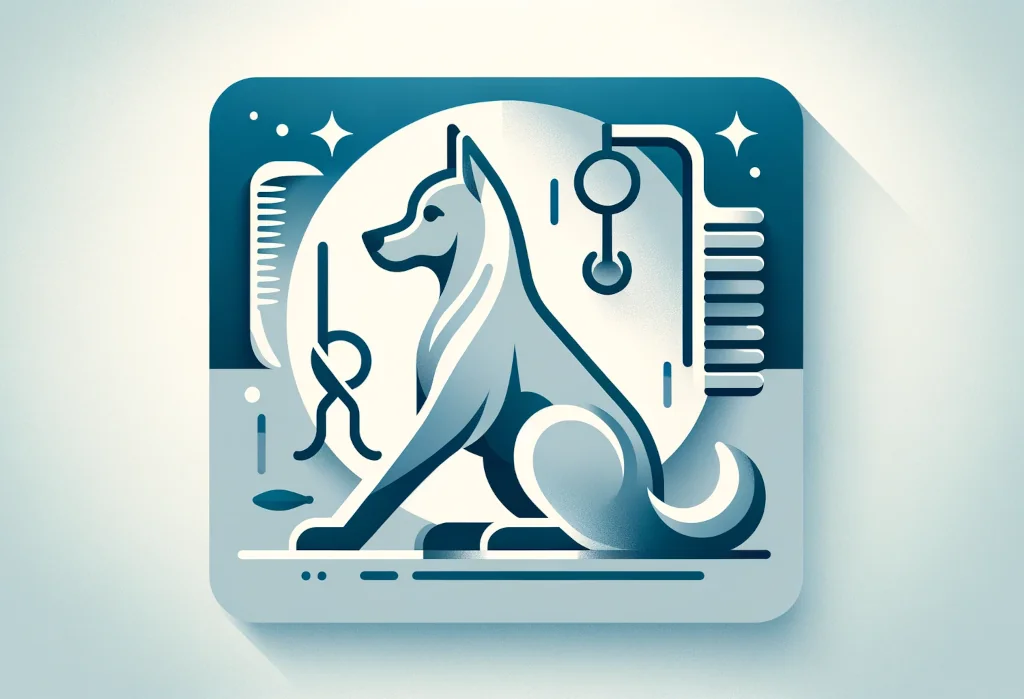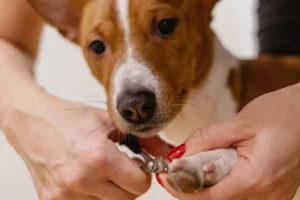Just when you thought a trip to the groomer would make Fido look and feel his best, he’s suddenly hobbling along like an old pirate. It’s like he traded his stylish haircut for a peg leg—something’s definitely afoot.
In this post, we’re going to explore the common causes and remedies for limping after a pamper session, so your four-legged friend can strut in style and comfort as soon as possible.
Key takeaways:
- Quick nails, muscle strain from handling, and reactions to grooming products are key culprits for a dog’s post-grooming limp.
- At home, ease your pet’s discomfort with pet-friendly balms, a restful space, and gentle massages.
- Consult your vet if the limp persists for over 24 hours, is worsening, or is accompanied by pain and behavioral changes.
Why Is My Dog Limping After Visiting the Groomer?
You’re probably puzzled if you’ve noticed your four-legged pal isn’t quite strutting their stuff as usual after a day at the groomer’s.
Dog limping after grooming can spring up for a few common reasons. Perhaps the most familiar culprit is quicked nails. If the groomer accidentally clips too close to the quick, that can cause discomfort or even a little bleeding, leaving your dog tender on their paws.
Soreness from handling is another potential cause, especially for dogs that aren’t used to being fussed over. Groomers often have to maneuver dogs into different positions to get them looking just right. If your pooch isn’t a yoga enthusiast, this might lead to temporary strain or stiffness.
Then, there’s the tools and techniques angle. Sometimes, a reaction could stem from a clipper burn or a nick from scissors. Groomers are generally pros at avoiding these mishaps, but accidents can happen, particularly if Fido is fidgety. Another unique pointer, often overlooked, is clipper anxiety—the vibration and noise can unsettle some dogs, causing them to tense up during grooming, which might lead to muscle strain.
If your dog’s showing signs of discomfort after grooming, first check those paws and legs for any cuts or bleeding. Then, it might be worth giving a gentle massage to help soothe any muscle soreness. If this doesn’t seem to help or your pal is in visible distress, don’t hesitate to ring up your vet.
Could It Be an Allergic Reaction to Grooming Products?
Could it be the sudsy stuff leaving your dog’s strut wonky? Certainly, allergic reactions to grooming products aren’t unheard of. The shampoo that leaves your pooch smelling fresh as a daisy might also cause skin irritation or an allergic dermatitis if they’re sensitive to the ingredients.
Identifying symptoms of allergies includes spotting excessive scratching, redness, or inflammation on the skin—oh, and hair loss in severe cases. However, allergies affecting a dog’s gait are less common. If the reaction is localized, say on the paw or leg, it might be mistaken for a limp.
If any product used during grooming is the suspected offender, a good rinse with plain water might clear off the irritant. If symptoms persist or worsen, a vet trip is a must. They might recommend a hypoallergenic shampoo for future baths. Remember to always inform your groomer of any known allergies so they can steer clear of potential triggers.
Is It Just Stress or Something More Serious?
Ever considered that your dog’s post-grooming hobble could be more about nerves than actual aches? Grooming can be an emotionally taxing event for some dogs, period. Stress or anxiety can indeed manifest as a limp because when a dog is stressed, they may hold their body differently, shifting weight away from a stressed area, which can look like limping.
Be on the lookout for other signs of stress in dogs such as shaking, panting, or hiding—all clues your buddy might be feeling the post-grooming blues. If it’s all about the stress, give your pup some space to relax in a calm environment. Treats or their favorite toy might also help lighten the mood.
But let’s not sugarcoat it; sometimes it’s not stress and actually something more serious. If the limp persists for more than a day, worsens, or is accompanied by other warning signs like refusal to eat, abnormal behavior, or excessive licking of a limb, it’s vet o’clock. Prompt professional assessment can prevent possible issues from escalating.
Remember, every dog’s different – and that goes for their grooming experiences, too. What’s trivial for one might be traumatic for another. Keep an eye out for any changes in behavior or movement post-groom, and when in doubt, the vet’s the best bet for peace of mind.
When your dog’s next grooming appointment rolls around, keep an open dialogue with your groomer about any past reactions. They’ll appreciate the heads-up, and it’ll help them tailor the grooming session to keep tails wagging, not lagging.
What Can You Do to Comfort Your Dog at Home?
When your furry best friend is feeling under the weather after a trip to the grooming salon, you’ll want to do everything you can to get that tail wagging again. Here’s how you can ease their discomfort right in the comfort of your own home.
-
Soothing Balms: Check out some pet-friendly balms or paw protectors. These can work wonders on irritated paws, and they often contain natural ingredients such as aloe or shea butter to promote healing and provide relief. Just be sure to keep an eye on your pup to prevent licking off the product.
-
Resting Space: Sometimes, all a dog needs is a soft, quiet place to recuperate. Make sure your dog’s bed is away from high traffic and noise. You can enhance the comfort by adding extra blankets for them to snuggle into.
-
Gentle Massage: Believe it or not, a gentle massage could be just the ticket to relaxation. Using a gentle touch, massage your dog’s legs, avoiding the sore spots. You might even notice them starting to relax and breathe more deeply as the tension melts away.
Here’s a unique tip that many might overlook: Initiate a distraction technique. If your dog is focusing less on the discomfort, they’re more likely to relax. How about a quiet play session with a new soft toy, or perhaps a food puzzle to occupy the mind? It’s all about shifting their attention to something positive.
When Should You Call the Vet?
Your pup has had their day at the spa, but now something seems off. It’s crucial to recognize when a limp is just a hiccup or a sign of a bigger issue lurking beneath the surface. Here are some red flags that tell you it’s time to ring up the vet:
-
Persistent Limping: If your dog is still favoring a leg after 24 hours, or the limp seems to worsen, it’s vet o’clock.
-
Visible Injuries: Any signs of cuts, swelling, or bleeding should be assessed by a professional.
-
Pain Indication: If your dog yelps when you touch a specific area or is notably uncomfortable, it’s more than just a little ouch.
-
Change in Behavior: Watch out for changes such as loss of appetite, undue aggression, or lethargy, which could indicate that the limp is just the tip of the iceberg.
Promptness in addressing these concerns with your veterinarian can save your dog from prolonged discomfort and possibly catch an issue that could become more serious if untreated. Remember, when in doubt, it’s always better to be safe and seek professional advice.
Don’t forget, an ounce of prevention is worth a pound of cure. Discuss with your groomer beforehand about your pet’s temperament and any past grooming experiences that might help them provide a more tailored, stress-free visit for your pooch. This proactive chat might just prevent post-grooming woes.
By providing your dog with tender, loving care at home and staying alert to any out-of-the-ordinary signs, you’ll ensure that your four-legged companion bounces back to their happy, healthy self in no time. Fetch some peace of mind by keeping your vet’s number handy, just in case the need arises. Remember, you know your dog best, and your intuition combined with these guidelines can make all the difference in their wellbeing.
Alex, a passionate animal lover, has experience in training and understanding animal behavior. As a proud pet parent to two dogs and three cats, he founded AnimalReport.net to share insights from animal experts and expand his knowledge of the animal kingdom.





